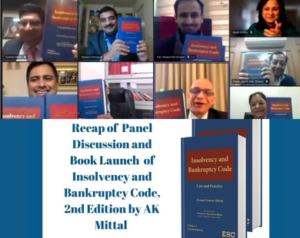Eastern Book Company released the second edition of the landmark book on Insolvency and Bankruptcy Law – titled Insolvency and Bankruptcy Code: Law and Practice by Akaant K Mittal. The virtual launch of the book took place on January 21, 2023, in the revered presence of eminent personalities such as Justice Ashok Bhushan, Chairman NCLAT and Former Judge SC, Justice Rajiv Shakdher, Judge, Delhi High Court. The event also saw the presence of Mr. Gopal Jain, Senior Advocate, Supreme Court, Mr. Bishwajit Dubey, Partner, CAM, Dr. Sanjeev Gemawat, GC, Vedanta Group, Dr Neeti Shikha, Faculty Lecturer, University of Bradford and Ms. Haripriya Padmanabhan, Advocate, Supreme Court.
The Book launch was followed by the panel discussion on the topic ‘Proposed Changes to IBC in upcoming Budget Session’. The event began with Ms. Nilufer Bhateja, Associate Editor, EBC Publishing Pvt Ltd., giving a welcome address and introducing all the panelists. Following this, Mr. Sumeet Malik, Director at EBC Publishing Pvt Ltd. addressed the viewers with insights on how this book is seminal in the interpretation of Insolvency and Bankruptcy Law. Mr. Malik said that he believes this book is evolving as an authoritative title on the subject, having earned high praise from Justice Suryakant, Justice Ravindra Bhat, Justice Pradeep Deshmukh and Mr Cyril Shroff in a very short period.
The event progressed with the address of Justice Bhushan who mentioned that IBC law is a new law on the horizon as it has been only 6 years since it was enforced and the speed with which it has picked pace within a few years is commendable. He mentioned that the 2nd edition of the newly released book contains all the recent judgments which clears all the doubts in the minds of the stakeholders. Further, he expressed gratitude towards the Eastern Book Company and its Editorial Board, stating that “Whenever we have to refer, we go for Eastern Book Company books and all lawyers use SCC for all the latest laws of the Supreme Court”.(sic)
Justice Rajiv Shakdher, the Guest of Honour, congratulated the author for his outstanding work and shared his views on IBC. He remarked that earlier debtors who couldn’t pay back were decapitated but society has moved on and become much more civilized since then. Enactments were made all over the world with the idea being anybody who is an individual or a corporate deserves a clean slate in life, if they have not siphoned off or diverted any money and just because of misfortune or errors of judgment their business has gone down then, so they deserve to restart their life. Justice Shakdher then went on to discuss the state of the current law and how to improve upon the same. He appreciated Mr. Akaant Mittal on enlisting few major areas where improvement is needed. He further appreciated the book, its quality of print, and not being able to find any errors in the book.
The welcome address of Justice Bhushan and Justice Shakdher was followed by the official book release. The panel discussion moderated commenced after that.
Justice Rajiv Shakdher, Judge Delhi High Court
Ms. Padmanabhan began the panel discussion by putting the first question to Justice Shakdher relating responsibilities being put on CoC or the Committee of Creditors and whether it is time for COC to be diluted and someone else to be given a larger responsibility for resolution. Justice Shakdher finds this to be common to the jurisdictions all over the world. He said that creditors generally don’t have any role unless there is any financial loss in the company. Only when
Justice Ashok Bhushan, Chairman NCLAT and Former SC Judge
Moving ahead, Ms Padmanabhan asks Justice Bhushan the main reason for NCLAT and NCLT to be overburdened with cases. Justice Bhushan identified the main reason was that the current law gives very little time to the Resolution
Dr Neeti Shikha, Faculty Lecturer, University of Bradford
On the question of that the proposed amendment is putting the Information Utility at a very high pedestal and is it going to add more complexity to which Dr. Neeti answers that it is a great move to make IU compulsory and information is important to us. Therefore, Information Utility is the backbone of IBC. Dr Neeti further went on to state that we need a
Mr. Gopal Jain, Senior Advocate, Supreme Court
Ms. Padmanaban next questions Mr Jain about his opinion on Information Utility (IU) and the concerns in making IU mandatory prior to filing the insolvency petition. Mr Jain answers by saying that the IBC is an evolving landscape as it
Mr. Bishwajit Dubey, Partner, Cyril Amarchand Mangaldas
Taking the discussion ahead, Ms. Padmanabhan asks Mr. Dubey about who is responsible for resolution not taking place usually and instead companies being liquidated. Mr. Dubey says that the cases are going the liquidation way due to
Dr Sanjeev Gemawat, General Counsel, Vedanta Group
Akaant Mittal, Advocate, High Court and NCLT Chandigarh and Author
Ms. Padmanabhan asks Mr Mittal about the most substantial change in IBC while drafting the second edition. Mr Mittal shares that the change from first edition to second edition is that the nexus between COC and the Resolution
Mr. Dubey concludes the discussion by congratulating the author in the words
“Kudos to Akaant to come up with the second edition at such a young age. It is a brilliant book that has set high standards. Thank you EBC for coming out with such a great book.”
The entire discussion can be seen below
The Book can be bought
Here

